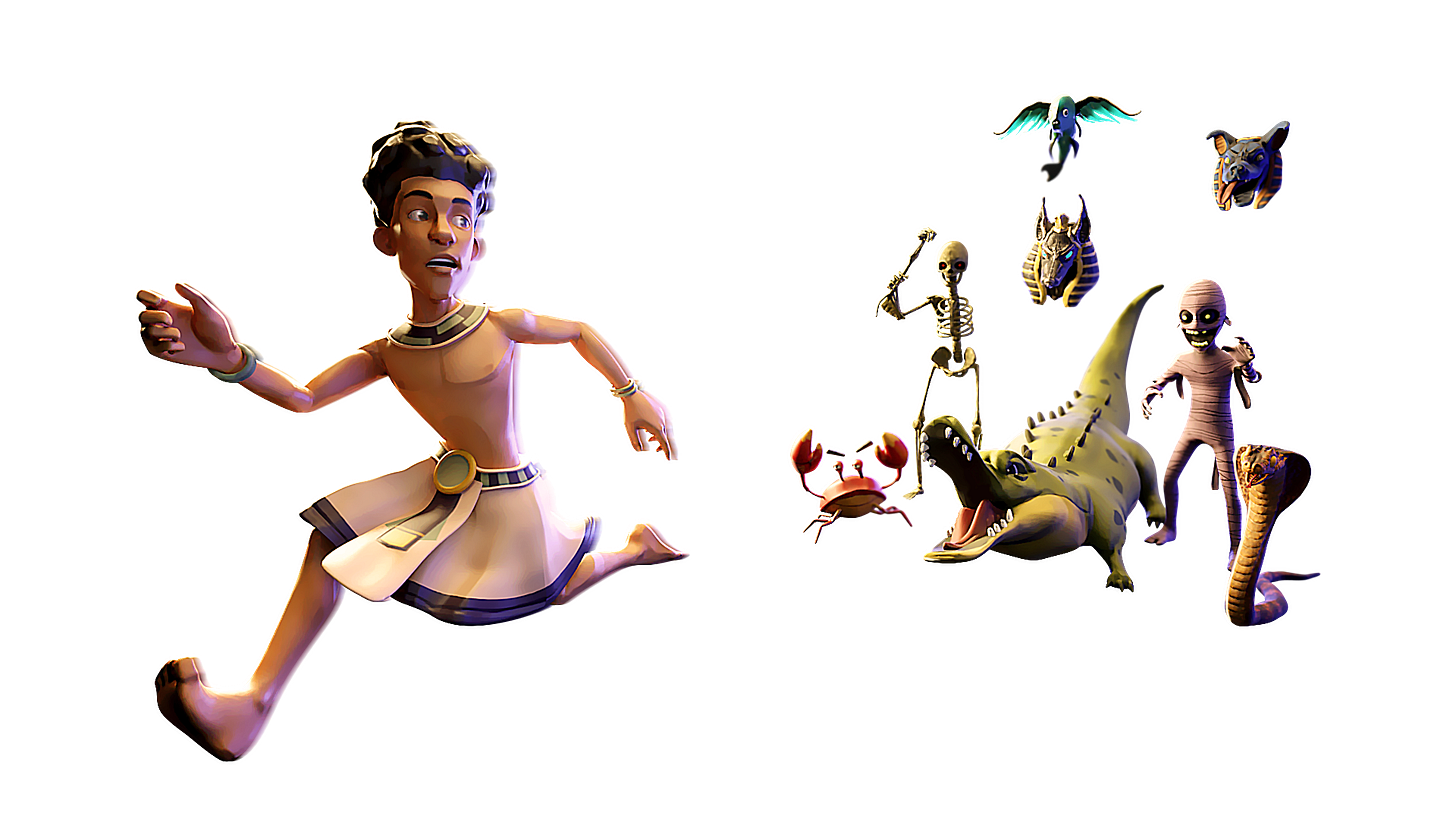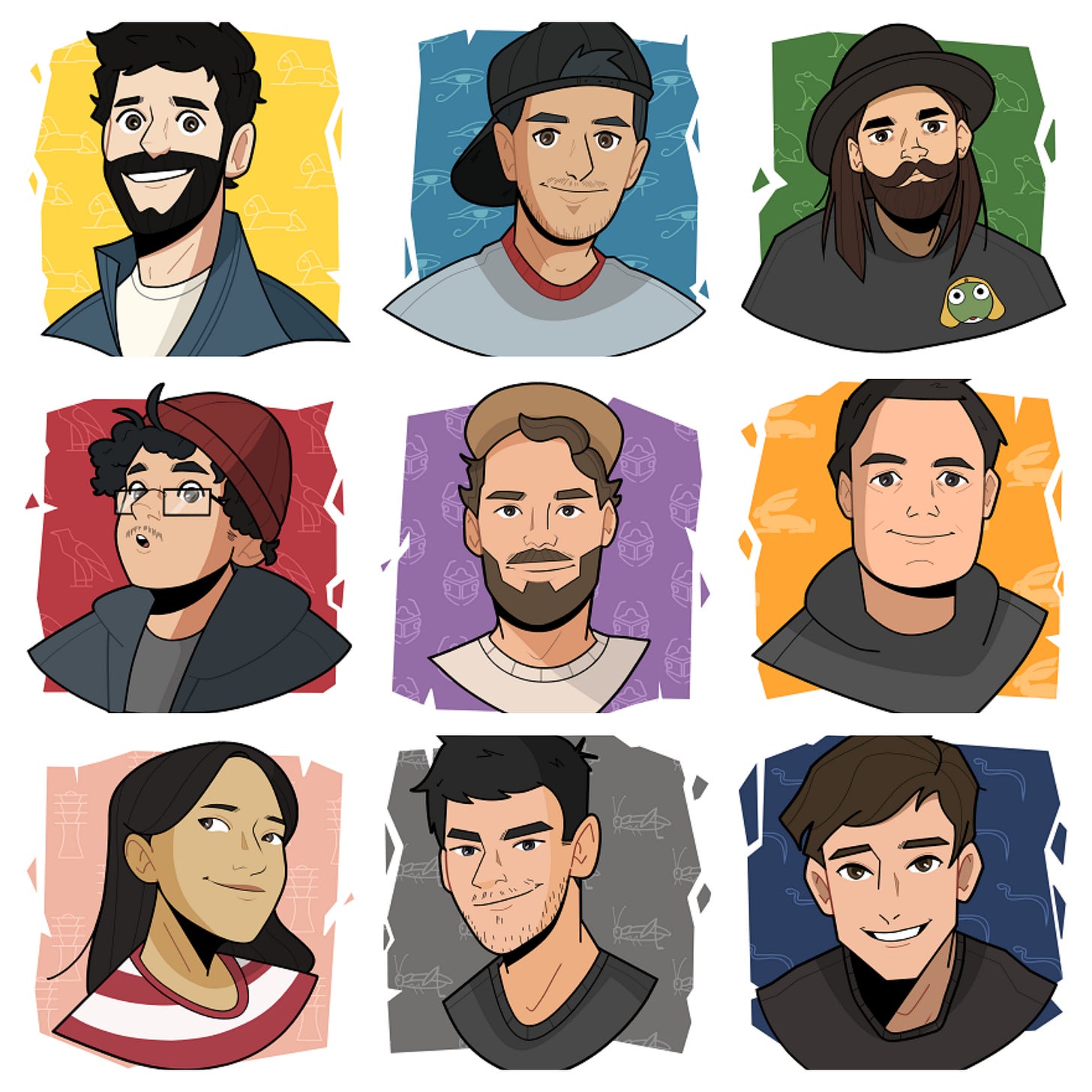To the Tut Community,
First and foremost welcome to the first devlog of Tut Trials. We’re excited to be extending the Tut universe beyond the webcomics and into gaming. We’ve always interacted closely with our community and we’re looking to continue that tradition by sharing the development process with our community through our discord where you’ll get all the updates, share your suggestions, sign up for the beta and chat directly to the development team.
Let me preface by saying that the order of operations that people expect from a devlog does not apply to Tut Trials. The reason for this is because we have already built an internal playable demo of seven levels taking Tut on a journey from Waset Harbor to the Throne Room of The Deities.
Level List
Waset Harbor
Waset Marketplace
The Nile Bank
Karnak Temple
Tomb of The First King
The Forgotten Caves
Throne Room of The Deities
The reason why you are not playing the demo is because we scrapped the gameplay. We just felt that the game wasn’t fun enough. We essentially set out to create adrenaline inducing platforming sequences and we ended up with something closer to running and dodging. The artwork will remain as you may have already noticed from our roadmap on our discord but we needed to go back and find the fun and that includes reworking our game design.
Reworking Core Game Mechanics
Movement system
Level design
Movement System
We knew immediately that the best control scheme for mobile was auto-run. We wanted the player to control the auto-run speed like in the DOS game Skyroads. We realized it wasn’t as fun as having the player focus on what they need to, fast paced platforming.
We added swiping, jump and slide. We also added leaping to the sides which ended up being a lackluster ability that wasn’t really used and we had branching paths but our pathing system wasn’t polished enough to handle smooth curving. What it boiled down to was that we weren’t having fun playing the game. The controls were too basic and the system we used didn’t allow us to polish it further either. We knew we had to scrap it.
We started from scratch and we so we’re currently working on a new movement system which already incorporates the base movements in a polished state. We also gave players more control of their jump through jump queueing and jump canceling. When Tut is descending then the player can queue another jump to launch Tut back into the air immediately on the first frame after landing. The player can also cancel Tut’s jump at any point mid air to get him back on the ground, a strategy players must learn as they traverse the more challenging levels in the game which require pinpoint precision. Easy to play, difficult to master.
When starting over we began with blocks to make sure the game feel is great and then layered the art over it. The new system uses machine states and it allows us to add powerups over the base system allowing for a more advanced movement system.
The Advanced Movement System
Wall Running
Wall Jumping
Rope Swinging
Jump Queueing
Jump Canceling
We have plans to include more powerups as the game develops.
Wall Running
This was a mechanic previously pioneered by Prince of Persia and we haven’t seen it since. We loved the versatility of the mechanic and the kind of level design it enabled and so we wanted to focus on that as we felt it lends itself well to platforming levels, mobile controls and our universe. We believe traversing the temples by means of wall running will be pretty fun!
Wall Jumping
Players can exit a wall run at any point through a wall jump. The natural run motion on a wall will be in the form of a curve until you naturally descend but if the player jumps off at the apex of the curve then they’ll land even farther than jumping off from anywhere else along the curve allowing for more strategic depth while exploring the level.
Rope Swinging
Inspired by Donkey Kong Country we wanted to allow the player to bypass ground hazards by rope swinging as an alternative to wall running. This gives the player the freedom to pursue the challenge in their preferred playstyle. We think that getting the timing right between ropes is a challenge in and of itself but we believe it’ll lend itself well to the new gameplay we have going.
Level Design
When we played our demo we realized that we designed the movement system around such basic controls that we couldn’t design levels beyond just running and dodging. We were just placing enemies on a map for players to avoid. There was a clear disconnect between making the level and placing the obstacles. David and I were working separately without coordination. This coupled with the gimped movement system resulted in gameplay that was not fun and so we had to change our whole approach to level design if we wanted to craft a true platforming experience.
Verticality
The new movement system allows us to leverage verticality, that means having players jump and land on a platform higher than the ground. Immediately we felt the shift in the experience, it was closer to true platforming. Suddenly the road was split and we could now design around the split with ease. Examples include an easy route and a hard route with more enemies but also more coins.
To take this a step further we added bounce pads that launch Tut in the air to land on platforms even higher than usual. This allowed us to create a new ground in the air, doubling the amount of routes a player can take.
Moving Platforms
We’re implementing platforms that move. Mixed in with verticality and suddenly we have areas in the level where the player jumps bounces into the air and has to precisely time their landing and their jump canceling or jump queueing.
Level Sequences
We now use a concept we refer to internally as level sequences. Essentially we create small challenges for players to overcome and with the advanced movement system verticality and moving platforms we can create a really fun level sequence that stands solid on its own. Similar to testing movement with blocks, we test levels by creating sequences on their own and when we feel they’re fun to play and offer strategic depth we move them to the actual level. A level is made up of many sequences.
Designing For Strategic Depth
When we design a level sequence we need to make sure that each sequence offers a multitude of routes to pass it, which is now doable due to our new movement and level design systems. This allows us to design for a core gameplay experience that’s challenging while also offering a more accessible route for new players who aren’t familiar with the platforming genre.
We create strategic depth by rewarding players who take the hard route. Rewards come in the form of coins which can be used in a variety of ways. Players who take multiple difficult routes can end up with more interesting rewards such as access to a treasure room or an Easter egg.
Lessons Learned
The most important thing for us going forward is learning from our experience. We need to iterate as early as possible focused solely on finding the fun in the gameplay.
Karnak Quality is something we speak a lot about internally and I think when faced with adversity we stuck to our values of pursuing Karnak Quality rather than continuing to build something we knew we weren’t proud of, even if it meant scrapping a lot of the work and starting over.
Roadmap
At the moment we’re working on polishing our movement system and reworking the entire Tomb level from the ground up using level sequences. Our goal is to get that up and running and when we’re happy with it we’ll continue to iterate and polish.
The Team
The rockstars who endured months of hard work and revisions. Together we are going to create a better game for you all to enjoy.
Thank you for reading and we’ll see you in the next devlog where we’ll talk about our design pillars for the game.
-Mo
Studio Director


